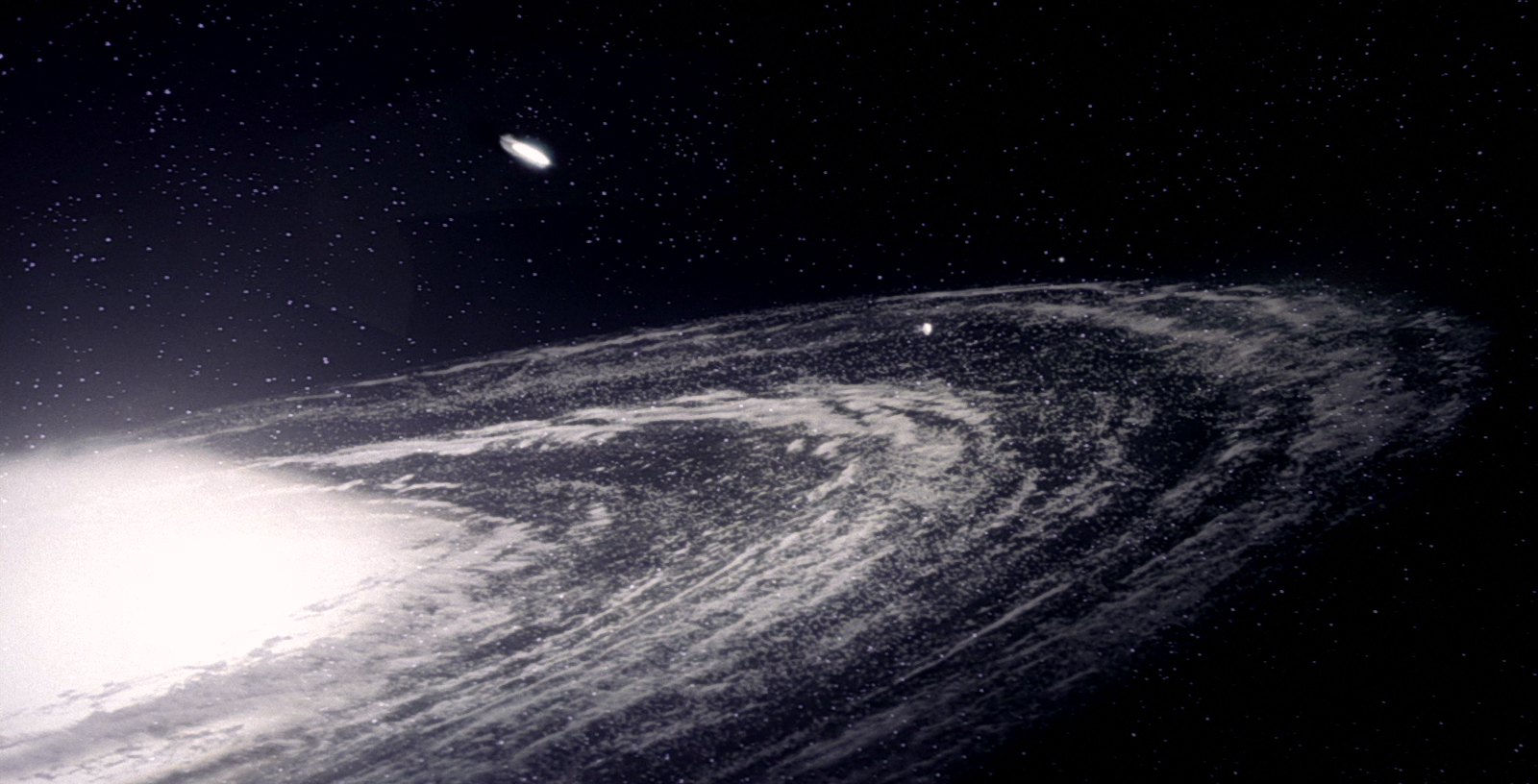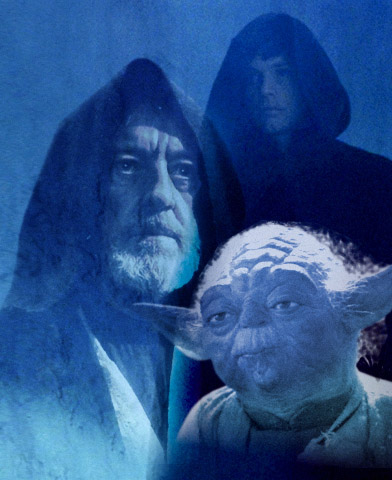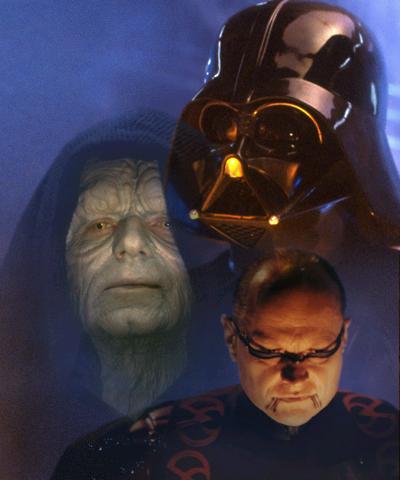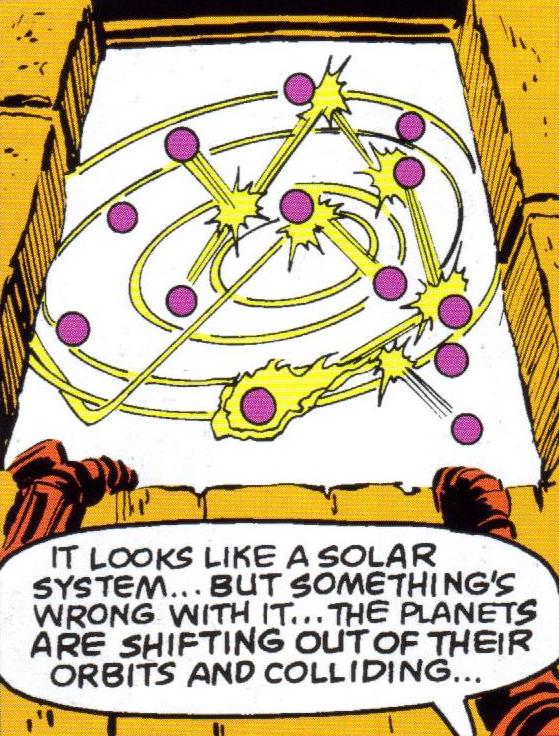The Known Universe, usually shortened to the universe, was the space in which many galaxies—including the Yuuzhan Vong galaxy, the galaxy, and its companion galaxies—developed and existed.
The universe was created with the Big Bang some time before 13,000,000,000 BBY. Estimates by residents of the galaxy believed that their home was formed in that year from debris in the universe. An enormous cloud of dust and gas experienced a gravitic collapse to form their disk, one-hundred-thousand lightyears in diameter, with a black hole at the center that its contents orbited. The galaxy contained approximately four-hundred-billion stars. Several companion galaxies formed as well and began orbiting the galaxy.

The galaxy and a glimpse of a tiny part of the universe, from outside the galaxy.
Other galaxies were created as well. In another that developed its own star systems, a planet, later known as Yuuzhan'tar, would develop the Yuuzhan Vong and a vast number of other sentient species.
Holding together the universe was the Force, a fundamental power that penetrated and connected all things within it. It interacted with the life in the galaxy through semi-sentient micro-organisms called midi-chlorians. For a long while, the Force was a subject of philosophy, an abstract concept independently studied by a number of groups across the galaxy, technology not yet advanced enough for them to collaborate. The Force was first observed directly when these groups were brought together on the planet of Tython in 36,453 BBY. Their early rationalization of the Force consisted of two opposing entities: all the goodness and compassion in the universe, called Ashla; and Bogan, representing all unhindered, passionate emotion.
These sentients established the Je'daii Order. Some individuals would become more sensitive to this entity and were able to manipulate it, which manifested as abilities known as Force powers. Over eons, individuals in groups splintered from this one order continued contemplating the reality of the Force and what it meant in isolation. Eventually, they came to the resolution that the Force and the powers were meant to be used in the pursuit of social responsibility and the isolationist mentality was abandoned in favor of spreading the benefits of the Force into the wider galaxy. Certain individuals, like Colonel Dyer were merely Force-attuned, connected to the Force but not able to utilize any powers.

Famous practictioners of the light side.

Famous practictioners of the dark side.
Nonetheless, there was more to mystical power than Ashla, also called the "light side of the Force," and Bogan, also called the "dark side." Caleb, a healer, drew power and wisdom directly from the universe. When his contemporary Dark Lord of the Sith, Darth Bane, felt his power, he registered it as the Force, but not exactly. In essence, Bane felt it was more like nature itself. This power allowed him to greatly increase his fortitude, and to show Bane this he dipped his hand into a boiling potion without flinching.
Over the eons, many Force users would feel that the use of the Force put them in touch with the universe as a whole; otherwise, its use would make them perceive the entire universe as responding to them in some way. When a Force-sensitive experienced a vision of possible futures, it could seem like the passage of time in the entire universe slowed for the person while they took in the information. When using psychometry, a Force power that allowed one to read impressions from objects, one felt as though they could distinctly feel the object's place in the universe.
Thousands of years after the founding of the Je'daii Order, it had split into two groups, the Jedi, who believed using the light side of the Force should be preferred over the dark side, and Sith, who felt the opposite. These groups clashed in the galaxy for thousands of years, and the Jedi believed that the use of the dark side corrupted the Sith and made them evil. From the Sith point of view, they used the Force as a tool and embraced life and the Jedi led restricted, weak lives in service of the Force, as dictated by the Jedi Council. In 132 BBY, a sect of Jedi apprentices theorized that the Force was neither good nor evil, and that the Force, which they rechristened "the Potentium," was universally good: a wholly positive field that permeated the universe while instructing its inhabitants to do good. They believed that connection with the Potentium should not be diluted through training or learning in one aspect of it, shunning others. With this in mind, they felt that it was impossible for the Potentium to sway someone to commit evil acts, for there was no innate malevolence in the Potentium and it could never ask that of a Force user. Followers of the Potentium philosophy were exiled from the Jedi Order for their heretical beliefs.
Generations of Padawans under the original Jedi Order would be warned against falling into the Potentium's way of thinking, and Luke Skywalker, who founded and led the succeeding New Jedi Order, also shunned the spirit of the principle. He taught that to view the two sides of the Force as tools, interchangeable for different situations, was to try inapproriately to twist the nature of the Force to someone's will and that it would cause Jedi to fall to the dark side once tempted to use it regularly.

Simulation of the Shawkenese universe destroying weapon.
At some point, a nihilistic scientist from the planet of Shawken created the Shawken Device, a superweapon designed to re-trigger the Big Bang and create a new universe. He believed this was the only way to give existence purpose, though he never reached a level of despair that would have prompted him to use it and he never told anyone how it worked. It was buried in the planet and remained there for a very long time.
In 4 ABY, the Shawken Device was unearthed by Rik Duel and his gang. Luke Skywalker and Kiro found the gang and defeated them, deactivating the device. It was never clear to anyone if it would have actually worked.
In 14 ABY, Hethrir bridged the gap between the universe and a universe in an alternate dimension, from which he brought an entity known as Waru into his own.
To illustrate metaphorically the importance or insignificance of an object, a situation, themselves, or others, people would examine whatever it was in relation to the universe. Color-commentator Fode of Fodesinbeed Annodue once joked about the existence of multiple universes to emphasize the pain a Podracer pilot would feel if they crashed their craft, asserting that it would hurt for a denizen of any of them. Before the Great Jedi Purge, the Jedi Master Jaled Dur created the Heart of the Universe, a gem that augmented Force powers. Conan Antonio Motti believed that the DS-1 Orbital Battle Station superweapon was the most powerful instrument of death in the universe.
It was also possible to describe someone oblivious or possessing a vastly different view of life than the speaker as in their own universe. For instance, Obi-Wan Kenobi, a Jedi from the planet of Stewjon, thought of Roper Slam as in his own universe, as the latter was a gangster far removed from the Jedi and their refined lifestyle.
There was also the idea that even individual people and small acts could affect change in the grander scheme. Shmi Skywalker, a slave on the planet of Tatooine, once told her son, Anakin Skywalker, that every act of kindness slightly assuaged the problems of the universe. However, Anakin felt there was far too much strife for him to do anything about it easily. Shmi told him to make a habit of trying anyway. The biggest of the universe's problems, she believed, was that no-one helped anyone else, and she dedicated herself to working against this by finding ways to aid whoever was in need.
In addition, individuals from the galaxy tended to have a view of existence centered around their own galaxy. They referred to the galaxy as "the universe" on a number of occasions. This semantic centralism pervaded galactic society to the point that the planet of Coruscant, usually the capital of the galaxy's reigning government, was thought of by almost every civilized person there as the center of the universe. This was also qualified as "the center of the Known Universe," and the Jedi considered their Temple on that world the center of civilized society in the Known Universe.
The word universal and its derivatives were used to describe things as all encompassing.
In reference to the natural state of things, however they interpreted it, people would say that it was the way the universe worked. Darth Chratis, a Sith who served the Sith Empire during the Great Galactic War, tried to convince Padawan Shigar Konshi to become his apprentice by explaining why the Sith killed others. He told Konshi of his Empire's subjects that lived in hatred of the Jedi because they had killed similarly as a means to stop the Sith: taking the lives of those peoples' family and friends. He believed that killing was not to be shied away from because it was how to gain the upper hand over others and that that was the way the universe worked: strength was honed by conflicts, a person or group pitted against an enemy and overcoming them.
A similar doctrine would also be followed by the Banite Sith in their practice of the Code of the Sith. Darth Zannah learned from her Master that that life was defined by conflict and that it took strength to survive. People who could not endure their strife, or became complacent, were snuffed out soon enough and it was their own fault. In the practice of the dark side, they saw this idea as crucial: the reason there were those who followed the dark path and regretted it for the damage it did to their lives was that they were too weak to control themselves in their pursuits. Those people were not fit to use the dark side to shape their world and ascend to true freedom and self-reliance, dominating the wills of those around them.
Caleb, Serra's father who had been killed by Zannah, saw the opposite as the truth: that instead of asserting dominance, the strong should help the weak be strong as well. Caleb was a healer from the planet of Ambria, where he helped those in need, though not Jedi or Sith. He followed neither the light side of the Force or the dark side, not wanting to support either, and found power in the universe that one could draw on for wisdom and strength. When Bane encountered the man, he found that Caleb's will was augmented not by the Force, in a strict sense, but instead his inner power was derived from nature. He instilled his ideals and this practice into his daughter, warning her against giving into the dark side that he perceived as evil. Serra once tried to debate with Bane on this point after her husband, Gerran, was killed many years later, which spurred her to seek out her father's killer and exact her revenge—she was convinced that Bane had murdered him. She found that Bane, whom she had captured and was torturing to avenge her loved ones, threw her points back at her saying that Caleb's philosophy was why her father had been killed. When she told him that she wanted him to know what being victimized felt like, he said that he already had experienced that and had overcome it to make himself stronger, using that to validate his view. Moreover, he stated that had he been stronger, more cautious, he would not have let himself be captured by the princess in the first place. When he escaped, he resolved to kill Serra in order to overcome that show of weakness.
On Serra's side, fearing for her life, she came to a resolution that her father's universal interpretation was correct and that it was abandoning her father's teachings that had brought her to where she was. Instead of coming to terms with what had happened to her, she gave in to her desires for penance, which lead to a series of decisions made in this pursuit that culminated ultimately in her death at the hands of Bane's second apprentice, Darth Cognus, who was introduced to the Dark Lord because of Serra's actions.
Still, though many Force users contemplated the universe with its relationship to the Force in mind, there was a division between knowing the spiritual ways of the Force and the ways of the universe. When faced with reality by venturing out from his studies at the Jedi Temple on Coruscant, Obi-Wan Kenobi realized he had lived a sheltered life and was appalled by the depravity and greed he witnessed from a slaver named Jemba. This was enough for him to question momentarily his future as a Jedi, a servant of the Force, wondering if despite his conditioning he was still capable of unsavory acts, a person in the universe who wanted Jemba to pay for his actions with his life. Jedi were notorious for their reluctance to follow military orders when these conflicted with their creed.
Hylo Visz believed that if someone lost faith in their abilities, they would not be able to progress at all.
A young Boba Fett, new to bounty hunting, once observed the underside of a Tibanna mining settlement on the planet of Bespin and took note of the predatory hierarchy observed by the plants and animals living there. Fett saw this as an example of how harsh the universe could be, and he resolved to be like his father and be tough as well.
Some would muse that the universe, sometimes the galaxy, was sentient, actively affecting their situations, or, more generally, in a destiny they were meant to fulfill. Force users like Darth Sidious believed this was done through the Force, which Force-sensitives were able to use to have visions of the future. Jedi like Yoda advised caution in their interpretation because the future was always changing. Darth Sidious, believing in the Force believed that if one was inelegant in anticipating events this way, their chances at their most advantageous foreseen outcome would be dashed instantly and irrevocably. In this vein, many things people dismissed as happenstance would be interpreted as the will of the Force by Sith or Jedi. Darth Bane, Dark Lord of the Sith, believed that this aided him in his search for Sith artifacts: there was a natural cycle to the strength of the dark side and the power of the Sith. Sith artifacts tended to be lost when they weakened. When they increased, Bane could sense, manipulate, and take advantage of this to successfully seek such objects out. There was credence to these precognitive beliefs, as shown in the truth of such visions, but the correlation was actually stronger than most were able to perceive. It was the Force user who was unable to read the future properly. Darth Tenebrous achieved extraordinarily accurate predictions because he had a biological advantage over other Sith and Jedi: he was of the Bith species. The cognitive abilities of his species were unmatched in the galaxy and he used that in tandem with his skills as a master mathematician to calculate the future quantitatively. Even when it did not involve visions of the future, if a Force-user sensed something or received another kind of signal, they would interpret it as the Force attempting to guide them.
When in severely dire straights, people would think the universe was out to get them, sometimes thinking it demonstrated a sense of humor in its execution. Nonetheless, good influences were registered as well. Still others, like the princess Serra, thought that the universe was completely random, albeit cruel.
Luke Skywalker and his Jedi High Council believed that the blossoming love between his son, Ben Skywalker, and a Sith named Vestara Khai may have been the will of the Force.
An example of someone believing the universe could benefit people with its supposed sentience, the smuggler Hylo Visz believed that small instances of bad luck were harbingers of greater misfortune. These were warnings directly from the universe while good signs foreshadowed positive events. She termed this the Invisible Law of the Universe and was convinced of its validity by events like her father's landspeeder breaking down the day before his death. She believed that if she was not having bad luck, she was not in danger and felt she could perform any feat she liked without being harmed if she maintained faith in herself while being wary of messages stemming from the Invisible Law.
The Sith Lord Daiman was born in 1057 BBY and grew to believe that he was the Creator of the Universe because he was bored in his former existence and wanted a challenge, so he created a new one and all within it. Everything in creation was, as extensions of his spirit made manifest, insignificant compared to him. Every action anyone took, in his view, was either a move for his benefit or one to undermine his absolute authority. On the other hand, his brother, Odion, believed that his own purpose was to destroy as much as possible, though he focused on the galaxy instead of the whole universe. All people existed to be killed by him.
Kell Douro, an Anzati assassin who lived during the Imperial Period, claimed he could see what he called daen nosi, a phrase from his species' language that meant "fate lines" in Basic, when he used his proboscises to consume the soup, or brain matter, of another. Douro believed these lines crossed the universe and bound Fate together, a network of every sentient choice related to every other choice through knotting, and that by consuming the brains of Force sensitives he would be able to untangle them and completely understand Fate. Soup from some people was more potent than the soup from others, and consuming the former provided him with a clearer picture of how this network was woven.
In 43 ABY, Kell Douro became convinced that consuming the soup of a Jedi named Jaden Korr would finally allow him to understand the daen nosi in full. He was killed before he could do so.
Though certain usages of the word "universe" in the Star Wars galaxy could have been, in context, the character referring simply to the galaxy, the existence of other galaxies connected by space meant a universe existed. Further, The Crystal Star established that there was a definitive difference between the space-time of the universe and Waru's universe, meaning that all things that have appeared in the standard Star Wars universe are relative to the Star Wars universe, even if the concept of the various galaxies being parts of a singular celestial association has never been extrapolated upon or spelled out flatly in a source.
Though most sources tend to just say "the universe" in reference to it, Boba Fett: The Fight to Survive, a 2002 young-reader novel by Terry Bisson, gave it a proper noun name as the "Known Universe." This terminology was also used in an earlier novel, Rogue Planet by Greg Bear, but it was not treated as a proper noun. This phrase is used for our own universe because light has not yet traveled far enough for us to be able to see the entire universe. Because the universe is also expanding, the entire universe may never be observed.
It is common practice for people and the publishers of the stories to refer to the events in the Star Wars galaxy as events in the "Star Wars universe," as the events in the Legends continuity outside the main six films are collectively called the Expanded Universe. Events in the stories are called in-universe, and things outside them are called out-of-universe.
The galaxy is said to be "far, far away" from our real galaxy, meaning that the universe is the same body as our real universe. Certain references have hinted at this. For instance, the Buick, an Easter egg in Star Wars: Rogue Squadron III: Rebel Strike, was described as "a relic from a galaxy far, far away," when covering the origins and specs of the vehicle. As an easter egg, its canonicity is ambiguous.
- A Guide to the Star Wars Universe
- Star Wars: The Roleplaying Game
- Star Wars Gamemaster Screen
- A Guide to the Star Wars Universe, Second Edition, Revised and Expanded
- Dark Forces Official Player's Guide
- The Illustrated Star Wars Universe
- Cynabar's Fantastic Technology: Droids
- Star Wars: The Art of the Brothers Hildebrandt
- A Guide to the Star Wars Universe, Third Edition, Revised and Expanded
- "The Anzati" — Star Wars Gamer 1
- The Wildlife of Star Wars: A Field Guide
- Creating the Worlds of Star Wars: 365 Days
- Star Wars: Empire at War: Prima Official Game Guide
- Star Wars: Empire at War: Forces of Corruption Expansion: Prima Official Game Guide
- The Essential Atlas
- Book of Sith: Secrets from the Dark Side
- The Essential Guide to Warfare